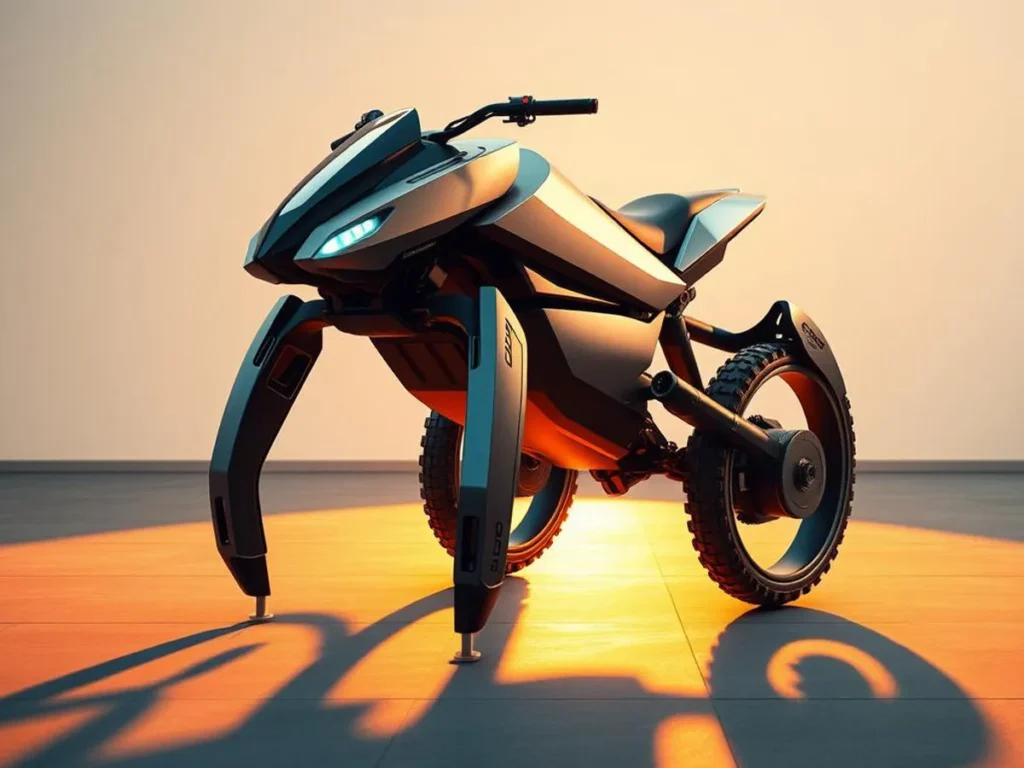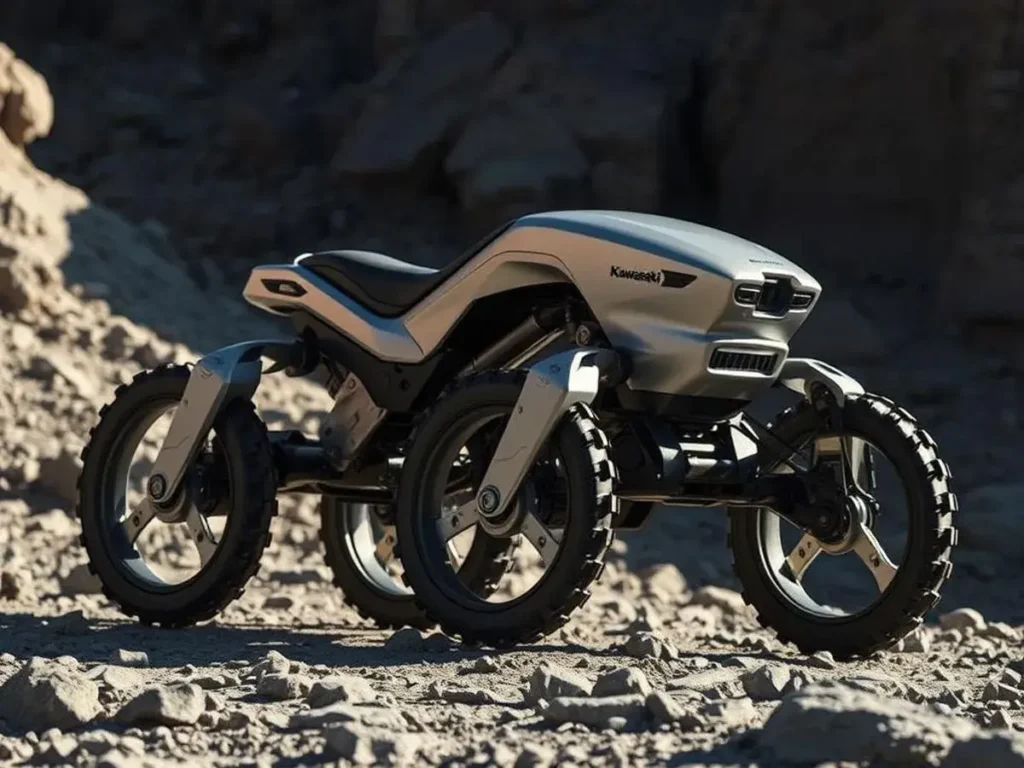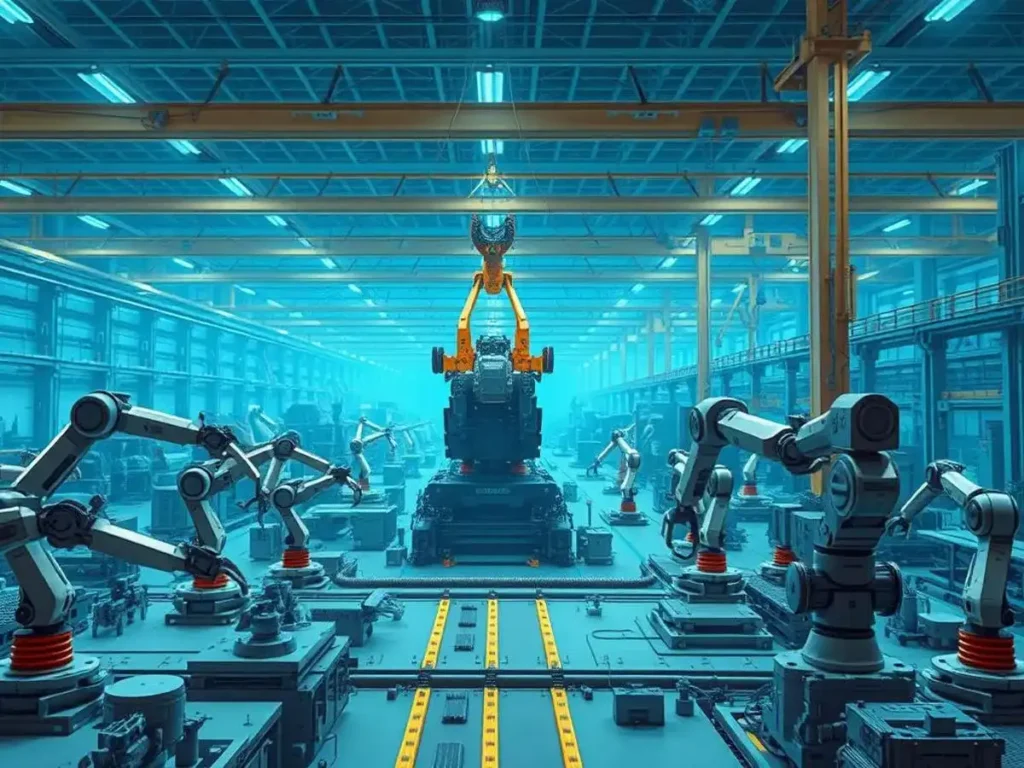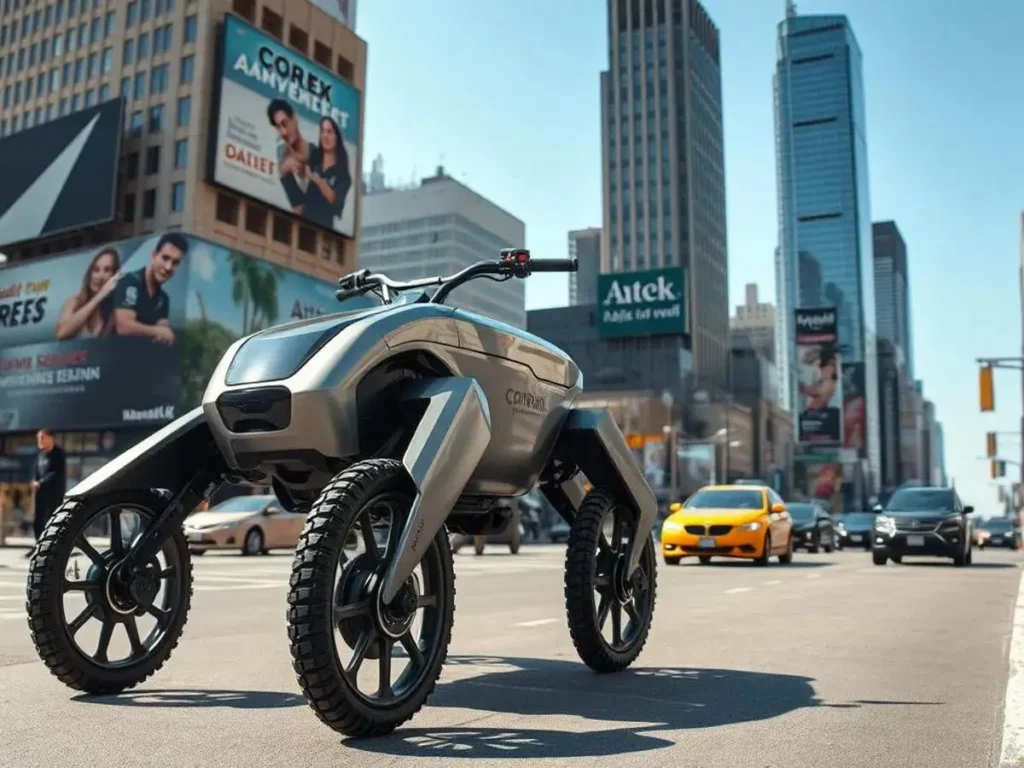Imagine your next ride having four legs instead of wheels. The Kawasaki Corleo is a game-changer. It’s a hydrogen-powered, four-legged robot bike that walks, runs, and moves like nothing else.

Kawasaki’s Corleo is more than a bike. It’s a mix of robotics and clean energy. It uses hydrogen fuel cells and a four-legged robotic body. This machine is a new way to move around.
It can climb stairs, cross rough ground, or balance on two legs while moving fast. Hydrogen powers it, making it clean and long-lasting. The four-legged design works where wheels can’t.
This technology could change how we travel, work, and even respond to emergencies. It’s a big step forward in personal transport and beyond.
Introducing the Kawasaki Corleo
Kawasaki’s Corleo changes how we move with its robotic quadruped design. It combines advanced robotics with hydrogen power. This vehicle walks and drives, aiming to solve urban problems while being eco-friendly.
Background and Concept
Kawasaki engineers were inspired by nature. The Corleo’s four legs handle rough terrain better than cars. It runs on hydrogen fuel cells, cutting down emissions and staying powerful. This mix of green tech and robotics is a big step forward.
Initial Reception and Industry Buzz
The Corleo made a splash at the 2023 Tokyo Tech Expo. Experts saw its value in disaster relief and logistics. Social media was filled with #FutureOfMobility, showing people’s enthusiasm. Critics called it a breakthrough in future transport.
Hydrogen Fuel Technology: Powering the Future
Hydrogen fuel cells are changing how quadrupedal robots like the Kawasaki Corleo work. They don’t use batteries like usual. Instead, they make energy from chemical reactions, leaving only water vapor behind.
This clean method meets global goals for sustainability. It also gives the robots a lot of power.
Benefits of Hydrogen Energy
Hydrogen gives the robots more energy, so they can go longer without refuelling. Refueling is quick, taking just minutes, not hours. This is great for emergency work or industrial tasks.
Since they don’t emit pollution, they’re perfect for cities and outdoor use. This makes them better for the environment.
Innovative Fuel Systems
Kawasaki made the fuel cells small enough to fit inside the robot. They also created safe ways to store hydrogen. This keeps the robot balanced and efficient.
These systems let the robot easily switch between walking and riding. This makes it better at moving in different ways.
Innovative Design and Engineering
The multi-legged robot design of the Kawasaki Corleo changes how we think about moving around. Engineers focused on making it agile and adaptable. They created a body that moves like an animal but uses advanced robotics.
Each leg joint is made of lightweight, strong alloys. This lets the Corleo move smoothly from walking to riding. It’s a big step forward in how robots can move.
The Corleo’s legs can move on their own. This lets it go over rough ground or through city streets. Its hip joints and fast-acting parts keep it stable, even when it’s moving fast.
This design is different from the usual two-wheeled vehicles. It shows how being versatile is more important than being specialized.
The Corleo’s design is easy to fix and looks good. It has hydrogen fuel systems that don’t get in the way of its legs. Every joint has sensors and computers that work together. This makes the Corleo a model for future robots.
Exploring the Capabilities of the four-legged robot
The robotic quadrupedal system in the Kawasaki Corleo offers unmatched mobility. It’s designed to work in many places, from rocky areas to city streets. It uses sensors and algorithms to adjust quickly, making smooth changes between walking, running, and climbing.
Field tests show it can handle slopes, stairs, and uneven ground with ease.

Performance and Agility
The system’s agility is impressive. It goes from 0 to 30 mph in seconds and stays balanced during quick turns. Its legs move on their own, keeping it steady on tricky surfaces.
Emergency teams could use it to reach places cars can’t. It’s also great for delivery services, moving through sidewalks and narrow paths.
Stability and Maneuverability
Stability is key for reliability in tough situations. It uses advanced gyroscopic technology to stay upright, even when jumping or stopping suddenly. Tests prove it can handle 45-degree slopes and uneven ground without slipping.
It’s perfect for navigating tight spots, like collapsed buildings or crowded streets. This makes it great for rescue missions and delivering goods in tight spaces.
Advantages of a Robotic Quadrupedal System
The four-legged robotic platform changes how we think about moving around. It’s much more stable than old-fashioned systems. This is because it has four legs, unlike wheels that slip on rough ground or two legs that can’t balance well.
Each leg can move on its own. This means it can go over stairs, rubble, or even slopes without trouble. It’s much better at handling tough terrain than wheels or two legs.
This design also means it can move with great precision. It can pick up tools or go through tight spaces. This makes it perfect for jobs that need careful control.
Imagine using it in places where cars can’t go. It could help in disaster zones or even help with deliveries in busy cities. Its ability to adapt makes it a top choice for new robotics.
In cities, this robot is a game-changer. It can go through construction sites or climb over curbs easily. Kawasaki’s focus on making it adaptable makes it a key player in robotics. It’s not just for moving things; it’s also a leader in advanced robotics.
Cutting-Edge Robotic Legged Machine Features
The Kawasaki Corleo brings new ways for robotic legged machines to interact with their surroundings. It uses the latest sensors and algorithms for better adaptability and precision. This means the robot can easily move on different terrains, from rough trails to city streets.
| Feature | Description |
|---|---|
| LIDAR and Camera Arrays | 360° environmental mapping for obstacle detection |
| Inertial Measurement Units (IMUs) | Stabilization during high-speed movements |
| Pressure Sensors | Real-time terrain analysis for step adjustments |
Advanced Sensors Integration
The robotic legged machine has many sensors that work together. It can process data 100 times every second. Lidar, cameras, and footpads help it understand its environment.
This setup lets the machine dodge obstacles and stay balanced on uneven ground.
Adaptive Mobility Algorithms
Special algorithms help the robotic legged machine learn about different terrains. It can change its path-planning software to fit various situations. This ensures it performs well in all kinds of environments.
The Future Impact on Mobility and Urban Transportation
The quadruped robot design of the Kawasaki Corleo suggests a new urban future. Cities might see these robots on sidewalks, delivering goods, or helping in emergencies. Their ability to move on uneven ground makes them perfect for places where cars struggle.
Picture these robots easing traffic by making last-mile deliveries. Their small size and climb-anywhere feature could change how we get around cities. They could also help public transit systems, making travel greener and faster.
Streets might soon welcome both humans and robots. The Corleo runs on hydrogen, fitting right into green goals. This quadruped robot design could lead to a cleaner, more efficient city life. As tech improves, these robots might even ride bike lanes or help in disasters, showing their wide range of uses.
Behind the Scenes: Robotics and Automation Integration
The Kawasaki Corleo’s advanced movements come from a hidden network of robotics and automation. This system makes sure the machine fits into its environment while keeping precision. Engineers worked hard to make it both quick and safe, even when doing complex tasks.

Software and Control Systems
The Corleo’s heart is its real-time software, which uses data from sensors. This system changes speed and balance fast. Algorithms look at the terrain and user inputs to make every step better. Engineers focused on error-proofing to cut down on delays between commands and actions.
Collaborative Robotics
The Corleo is designed for human-robot teamwork. Users control the machine with easy-to-use controls while it makes small adjustments on its own. This partnership makes the job easier for users and makes the machine more reliable. Tests have shown that this teamwork helps navigate through unexpected situations.
Sustainability and Environmental Benefits
The Kawasaki Corleo leads in eco-friendly transport by focusing on sustainability. Its hydrogen fuel cells only produce water vapor, cutting out harmful emissions. This could greatly reduce air pollution in cities, making them cleaner.
It’s making use of recycled materials and energy-saving lines, cutting down on waste. The design is built to last, reducing the need for frequent replacements. This approach supports global sustainability goals, showing a path for future transport.
The Corleo promotes a move to zero-emission systems. Its use could encourage other industries to follow, creating a big change. This shows that new tech and caring for the planet can go hand in hand.
Market Implications in the United States
The Kawasaki Corleo’s success in the U.S. market depends on matching consumer wants and policy changes. Cities like Los Angeles and Boston are keen on hydrogen cars because of green mandates.

Consumer trends show that more people want green tech. A 2023 survey by the National Association of City Transportation Officials found that 68% like zero-emission vehicles for city use. Early tests in tech cities could help these vehicles become more common, especially for deliveries and emergencies.
Consumer Trends and Adoption
Like electric cars, the Corleo’s adoption might start with the rich in certain areas. But, there’s a big problem: not enough hydrogen stations. Working with big names like Shell or BP could help, using their gas station networks.
Investment and Policy Perspectives
| Factor | Impact |
|---|---|
| State incentives | California’s 2025 hydrogen infrastructure grants |
| Federal funding | $9.5B allocated under the Inflation Reduction Act |
| Corporate partnerships | Toyota’s 2024 hydrogen alliance with Kawasaki |
Rules like the National Electric Vehicle Infrastructure Formula Program (NEVI) could help hydrogen tech. Even venture capital firms, like Bessemer Venture Partners, are backing startups in this field, showing they believe in it.
Conclusion
The Kawasaki Corleo is a blend of advanced robotics and green innovation. It uses hydrogen power and smart systems to cut down on emissions. This makes it a key player in the fight against climate change.
Its design is all about being fast and steady, thanks to its four legs. This makes it perfect for moving around in different places. It shows us that we can have fast and green transportation at the same time.
In cities, this technology could lead to cleaner and more flexible ways to get around. In the U.S., it could also change how we think about green technology. People might start to want more of these kinds of solutions.
The Corleo is more than just a car; it’s a new way of thinking about how we travel. With more work on hydrogen and robotics, it could change the future of transportation. It shows us how we can move forward while taking care of our planet.
Table of Contents
FAQ
What is the Kawasaki Corleo?
The Kawasaki Corleo is a new kind of four-legged robot bike. It uses hydrogen power and advanced robotics. This makes it a game-changer for how we move around.
How does the hydrogen fuel technology work in the Kawasaki Corleo?
The Corleo runs on hydrogen fuel. It turns hydrogen into electricity with a fuel cell. This electricity powers its four legs, making it green and efficient.
What advantages does the quadrupedal robot design offer compared to traditional vehicles?
Its four legs make the Corleo very stable. It can handle different terrains better than cars or bikes. This makes it perfect for city streets.
What kind of sensors are integrated into the Kawasaki Corleo?
The Corleo has advanced sensors. They help it understand its surroundings and avoid obstacles. This keeps it safe in busy cities.
Can the Kawasaki Corleo adapt to different terrains?
Yes, it can. The Corleo’s algorithms let it adjust to different surfaces. This boosts its agility and performance.
What are some potential applications for the Kawasaki Corleo?
It’s good for many things in cities. The Corleo can help with transport, logistics, and even rescue work. It’s very versatile.
How does the Kawasaki Corleo contribute to sustainability?
It uses hydrogen fuel, which is clean. This helps make cities greener.
What role does automation play in the functioning of the Kawasaki Corleo?
Automation is key. The Corleo’s software and systems work together smoothly. This shows off the latest in tech.
What is the market potential for the Kawasaki Corleo in the United States?
The U.S. market is promising. People are excited about new ways to move around. There’s support for hydrogen tech, too.
READ MORE BLOGS ON AI AND TECH FROM HERE


naturally like your web site however you need to take a look at the spelling on several of your posts. A number of them are rife with spelling problems and I find it very bothersome to tell the truth on the other hand I will surely come again again.
You’re so awesome! I don’t believe I have read a single thing like that before. So great to find someone with some original thoughts on this topic. Really.. thank you for starting this up. This website is something that is needed on the internet, someone with a little originality!
This is really interesting, You’re a very skilled blogger. I’ve joined your feed and look forward to seeking more of your magnificent post. Also, I’ve shared your site in my social networks!
Great information shared.. really enjoyed reading this post thank you author for sharing this post .. appreciated
I just like the helpful information you provide in your articles
I’ll definitely be coming back for more.
Excellent breakdown of the topic.